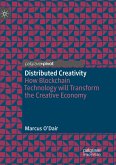Customization 4.0
Proceedings of the 9th World Mass Customization & Personalization Conference (MCPC 2017), Aachen, Germany, November 20th-21st, 2017
Herausgegeben:Hankammer, Stephan; Nielsen, Kjeld; Piller, Frank T.; Schuh, Günther; Wang, Ning
Customization 4.0
Proceedings of the 9th World Mass Customization & Personalization Conference (MCPC 2017), Aachen, Germany, November 20th-21st, 2017
Herausgegeben:Hankammer, Stephan; Nielsen, Kjeld; Piller, Frank T.; Schuh, Günther; Wang, Ning
- Gebundenes Buch
- Merkliste
- Auf die Merkliste
- Bewerten Bewerten
- Teilen
- Produkt teilen
- Produkterinnerung
- Produkterinnerung
This proceedings volume presents the latest research from the worldwide mass customization & personalization (MCP) community bringing together new thoughts and results from various disciplines within the field. The chapters are based on papers from the MCPC 2017. The book showcases research and practice from authors that see MCP as an opportunity to extend or even revolutionize current business models. The current trends of Industrie 4.0, digital manufacturing, and the rise of smart products allow for a fresh perspective on MCP: Customization 4.0. The book places a new set of values in the…mehr
Andere Kunden interessierten sich auch für
![Customization 4.0 Customization 4.0]() Customization 4.0133,99 €
Customization 4.0133,99 €![Managing Complexity Managing Complexity]() Managing Complexity192,59 €
Managing Complexity192,59 €![Business Innovation and ICT Strategies Business Innovation and ICT Strategies]() Sriram BirudavoluBusiness Innovation and ICT Strategies41,99 €
Sriram BirudavoluBusiness Innovation and ICT Strategies41,99 €![Distributed Creativity Distributed Creativity]() Marcus O'DairDistributed Creativity44,99 €
Marcus O'DairDistributed Creativity44,99 €![Disrupting Finance Disrupting Finance]() Disrupting Finance21,99 €
Disrupting Finance21,99 €![Distributed Creativity Distributed Creativity]() Marcus O'DairDistributed Creativity44,99 €
Marcus O'DairDistributed Creativity44,99 €![450 Keywords Digitalisierung 450 Keywords Digitalisierung]() Oliver Bendel450 Keywords Digitalisierung22,99 €
Oliver Bendel450 Keywords Digitalisierung22,99 €-
-
-
This proceedings volume presents the latest research from the worldwide mass customization & personalization (MCP) community bringing together new thoughts and results from various disciplines within the field. The chapters are based on papers from the MCPC 2017. The book showcases research and practice from authors that see MCP as an opportunity to extend or even revolutionize current business models. The current trends of Industrie 4.0, digital manufacturing, and the rise of smart products allow for a fresh perspective on MCP: Customization 4.0. The book places a new set of values in the centre of the debate: a world with finite resources, global population growth, and exacerbating climate change needs smart thinking to engage the most effective capabilities and resources. It discusses how Customization 4.0 fosters sustainable development and creates shared value for companies, customers, consumers, and the society as a whole. The chapters of this book are contributed by a wide range of specialists, offering cutting-edge research, as well as insightful advances in industrial practice in key areas.
The MCPC 2017 has a strong focus on real life MCP applications, and this proceedings volume reflects this. MCP strategies aim to profit from the fact that people are different. Their objective is to turn customer heterogeneities into opportunities, hence addressing "long tail" business models. The objective of MCP is to provide goods and services that best serve individual customers' needs with near mass production efficiency. This proceedings volume highlights the interdisciplinary work of thought leaders, technology developers, and researchers with corporate entrepreneurs putting these strategies into practice.
Chapter 24 is open access under a CC BY 4.0 license via link.springer.com.
The MCPC 2017 has a strong focus on real life MCP applications, and this proceedings volume reflects this. MCP strategies aim to profit from the fact that people are different. Their objective is to turn customer heterogeneities into opportunities, hence addressing "long tail" business models. The objective of MCP is to provide goods and services that best serve individual customers' needs with near mass production efficiency. This proceedings volume highlights the interdisciplinary work of thought leaders, technology developers, and researchers with corporate entrepreneurs putting these strategies into practice.
Chapter 24 is open access under a CC BY 4.0 license via link.springer.com.
Produktdetails
- Produktdetails
- Springer Proceedings in Business and Economics
- Verlag: Bournemouth University / European Commission / Springer / Springer International Publishing / Spring
- Artikelnr. des Verlages: 978-3-319-77555-5
- 1st ed. 2018
- Seitenzahl: 724
- Erscheinungstermin: 21. Juni 2018
- Englisch
- Abmessung: 241mm x 160mm x 45mm
- Gewicht: 1240g
- ISBN-13: 9783319775555
- ISBN-10: 3319775553
- Artikelnr.: 50921330
- Herstellerkennzeichnung Die Herstellerinformationen sind derzeit nicht verfügbar.
- Springer Proceedings in Business and Economics
- Verlag: Bournemouth University / European Commission / Springer / Springer International Publishing / Spring
- Artikelnr. des Verlages: 978-3-319-77555-5
- 1st ed. 2018
- Seitenzahl: 724
- Erscheinungstermin: 21. Juni 2018
- Englisch
- Abmessung: 241mm x 160mm x 45mm
- Gewicht: 1240g
- ISBN-13: 9783319775555
- ISBN-10: 3319775553
- Artikelnr.: 50921330
- Herstellerkennzeichnung Die Herstellerinformationen sind derzeit nicht verfügbar.
Stephan Hankammer is a research associate at the Technology and Innovation Management Group at RWTH Aachen University since 2014. He conducts research on ecologically sustainable business models, collaborative value creation, and sustainable consumption. He has been coordinator of a European ECO INNOVERA research project on sustainable mass customization in the consumer electronics industry. Moreover, he has worked on larger mass customization projects in several other industries in both B2C and B2B settings. His field of expertise is sustainable collaborative value creation and he is an enthusiastic interdisciplinary scientist interested in combining different research topics related to sustainable management, innovation management, and business ethics. Kjeld Nielsen is an Associate Professor for the Department of Materials and Production at Aalborg University. Kjeld Nielsen is head of the Mass Customization Research Group. His research interests include mass customization, product configuration, reconfigurable manufacturing systems, and product architecture. Frank T. Piller has headed the Technology and Innovation Management Group at RWTH Aachen University since 2007. Earlier, he worked at the MIT Sloan School of Management and was an assistant professor of management at the TUM Business School (1999-2004). Frank Piller graduated with a Ph.D. in operations management from the University of Würzburg in 1999. His post-doctoral Habilitation degree is from the TUM Business School. Frank Piller has worked as a consultant and delivered executive workshops for many international companies, including several DAX30 and Fortune 500 corporations. As a member of their board of directors or board of scientific advisors, he works with a number of innovative technology companies to bring his research into practice. His current research focuses on the need of established corporations to cope with the challenge of digital transformation and similar disruptive technological innovations. This includes a growing stream of research on digital business models and the systematic design of platform-based business ecosystems, but also research on Leadership for Industrie 4.0 and the establishment of organizational structures and cultures that allow for change. He is the Chairman of a cross-industry group hosted by VDI (Verein Deutsche Ingenieure) to develop standards in the field of platform-based digital business models ("Fachausschuss Geschäftsmodelle für Industrie 4.0"). Günther Schuh is a German engineer and has held the Chair for Production Systems at the RWTH Aachen since 2002. He is also Director of the Research Institute for Rationalization , a member of the Board of Directors of the Machine Tool Laboratory (WZL) of RWTH Aachen University and the Fraunhofer Institute for Production Technology (IPT). A further academic task is the management of RWTH Aachen Campus GmbH. Since 2004, he hasalso been on the directorate of the Research Institute for Operations Management (FIR) at the RWTH. From 2008 to 2012 he was Vice-President for Industry and Economics of RWTH Aachen University. Prof. Schuh has additionally worked in several supervising and management boards. Ning Wang is a research associate at the Technology and Innovation Management Group at the RWTH Aachen University since 2014. She conducts research in the area of mass customization & personalization, consumer co-creation and user toolkits design. Her research tries to extend the conventional mass customization and personalization understanding from a new perspective: smart products for customized product-services beyond the point of sales. She has been working on research projects of cross-cultural toolkits development for online customization, design parameters of the smart product-service system (Smart PSS) and how to achieve user satisfied customization and data-driven service personalization via a new form of smart product and user interaction design.
Part 1: Customization and Personalization via Smart Products and Smart Services.- Chapter 1: User-centered Service Innovation for Commercial Vehicles: Plugging in the Handyman market.- Chapter 2: Design for Mass Individualisation: Introducing Networked Innovation Approach.- Chapter 3: An Exploratory Study of User Interaction with Smart Products for Customization in the Usage Stage.- Chapter 4: Datamodels for PSS development and configuration: existing approaches and future research.- Chapter 5: Demand Engineering in Mass Customization Using a Data Driven Approach.- Chapter 6: Adapting Product-Service System methods for the digital era - requirements for Smart PSS engineering.- Part 1: Digital Manufacturing and Industrie 4.0.- Chapter 7: A Marketplace for Smart Production Ecosystems.- Chapter 8: Exploring Barriers Towards the Development of Changeable and Reconfigurable Manufacturing Systems for Mass Customized Products: an Industrial Survey.- Chapter 9: 3D Avatar Platforms -Tomorrows Gateways for Digitized Persons into Virtual Worlds.- Chapter 10: Automated processing of planning modules in factory planning by means of constraint-solving using the example of production segmentation.- Chapter 11: A digital fabrication infrastructure enabling distributed design and production of custom furniture.- Chapter 12: Mass Customization 4.0 in AEC: Additive Manufacturing for Innovative Building Systems.- Chapter 13: Managing Customized and Profitable Product Portfolios using Advanced Analytics.- Chapter 14: Impacts of Industry 4.0 on the specific case of mass customization through modeling and simulation approach.- Part 3: Mass Customization and Sustainability.- Chapter 15: Mass Customization and Personalization: a way to improve sustainability beyond a common paradox.- Chapter 16: Mass customization and environmental sustainability: a large-scale empirical study.- Chapter 17: Opportunities and Challenges of product-service systems for sustainable mass customization - a case study on Televisions.- Chapter 18: Effects of Mass Customization on Sustainability - A Literature-based Analysis.- Chapter 19: Exploring drivers and barriers for sustainable use of resources: The case of high-tech mass customizers in the German textile industry.- Chapter 20: A preparatory approach to Environmental Assessment for sustainable mass customization.- Part 4: Choice Navigation and Customer Interactions for MCP.- Chapter 21: The Importance of Choice Navigation in Starting Configurator Projects.- Chapter 22: User Interface Trends for Mobile Optimized Product Configurators.- Chapter 23: An Evaluation Model For Web-based 3D Mass Customization Toolkit Design.- Chapter 24: Front-end/Back-end Integration in Mass Customization: Challenges and Opportunities.- Chapter 25: Design and development of the CEM-dashboard - a diagnostic tool to determine your current position and improvement directions in customer experience management.- Chapter 26: Product Configuration in the ETO and CapitalGoods Industry: A Literature Review and Challenges.- Chapter 27: The Individualization of Mass Customization: Exploring the Value of Individual Thinking Style through Consumer Neuroscience.- Chapter 28: User Interface Modifications in Established Product Configurators.- Part 5: Solution Space Development and Variety Management.- Chapter 29: Data Driven Product Family Modelling with Feedback.- Chapter 30: Production Platform Development through the Four Loops of Concern.- Chapter 31: Integrate customer order decoupling point and mass customisation concepts: a literature review.- Chapter 32: Mass Customization in Food Industries: Case and Literature Study.- Chapter 33: Can the SME successfully adopt Mass Customization?.- Chapter 34: Productivity, Challenges and Applying Mass Customization in the Building and Construction Industry.- Chapter 35: Flexibility in Mass Customization of Houses.- Chapter 36: Product and service variety versus internal performance - towards new balances.- Chapter 37: Validation of Metrics for Mass Customization - a pre-study of validation methods.- Chapter 38: Teaching solution space development: Experiences from the Hanover Knowledge-Based-Design-Lab.- Part 6: Mass Customization of Textiles and Fashion Products as a Special Field of Application.- Chapter 39: Fashion & Apparel Industry 4.0 and Smart Mass Customization Approach for Clothing Product Design.- Chapter 40: Individual on-demand produced clothing - ultra fast fashion production system-.- Chapter 41: myShopNET: personalized consumer goods e-commerce platform.- Chapter 42: Mass Customization Practices of Malaysian SMEs Apparel Sector: An Exploratory Survey.- Chapter 43: Attitudes Toward Apparel Mass Customization: Canadian Consumer Segmented by LifeStyle and Demographics.
Part 1: Customization and Personalization via Smart Products and Smart Services.- Chapter 1: User-centered Service Innovation for Commercial Vehicles: Plugging in the Handyman market.- Chapter 2: Design for Mass Individualisation: Introducing Networked Innovation Approach.- Chapter 3: An Exploratory Study of User Interaction with Smart Products for Customization in the Usage Stage.- Chapter 4: Datamodels for PSS development and configuration: existing approaches and future research.- Chapter 5: Demand Engineering in Mass Customization Using a Data Driven Approach.- Chapter 6: Adapting Product-Service System methods for the digital era - requirements for Smart PSS engineering.- Part 1: Digital Manufacturing and Industrie 4.0.- Chapter 7: A Marketplace for Smart Production Ecosystems.- Chapter 8: Exploring Barriers Towards the Development of Changeable and Reconfigurable Manufacturing Systems for Mass Customized Products: an Industrial Survey.- Chapter 9: 3D Avatar Platforms -Tomorrows Gateways for Digitized Persons into Virtual Worlds.- Chapter 10: Automated processing of planning modules in factory planning by means of constraint-solving using the example of production segmentation.- Chapter 11: A digital fabrication infrastructure enabling distributed design and production of custom furniture.- Chapter 12: Mass Customization 4.0 in AEC: Additive Manufacturing for Innovative Building Systems.- Chapter 13: Managing Customized and Profitable Product Portfolios using Advanced Analytics.- Chapter 14: Impacts of Industry 4.0 on the specific case of mass customization through modeling and simulation approach.- Part 3: Mass Customization and Sustainability.- Chapter 15: Mass Customization and Personalization: a way to improve sustainability beyond a common paradox.- Chapter 16: Mass customization and environmental sustainability: a large-scale empirical study.- Chapter 17: Opportunities and Challenges of product-service systems for sustainable mass customization - a case study on Televisions.- Chapter 18: Effects of Mass Customization on Sustainability - A Literature-based Analysis.- Chapter 19: Exploring drivers and barriers for sustainable use of resources: The case of high-tech mass customizers in the German textile industry.- Chapter 20: A preparatory approach to Environmental Assessment for sustainable mass customization.- Part 4: Choice Navigation and Customer Interactions for MCP.- Chapter 21: The Importance of Choice Navigation in Starting Configurator Projects.- Chapter 22: User Interface Trends for Mobile Optimized Product Configurators.- Chapter 23: An Evaluation Model For Web-based 3D Mass Customization Toolkit Design.- Chapter 24: Front-end/Back-end Integration in Mass Customization: Challenges and Opportunities.- Chapter 25: Design and development of the CEM-dashboard - a diagnostic tool to determine your current position and improvement directions in customer experience management.- Chapter 26: Product Configuration in the ETO and CapitalGoods Industry: A Literature Review and Challenges.- Chapter 27: The Individualization of Mass Customization: Exploring the Value of Individual Thinking Style through Consumer Neuroscience.- Chapter 28: User Interface Modifications in Established Product Configurators.- Part 5: Solution Space Development and Variety Management.- Chapter 29: Data Driven Product Family Modelling with Feedback.- Chapter 30: Production Platform Development through the Four Loops of Concern.- Chapter 31: Integrate customer order decoupling point and mass customisation concepts: a literature review.- Chapter 32: Mass Customization in Food Industries: Case and Literature Study.- Chapter 33: Can the SME successfully adopt Mass Customization?.- Chapter 34: Productivity, Challenges and Applying Mass Customization in the Building and Construction Industry.- Chapter 35: Flexibility in Mass Customization of Houses.- Chapter 36: Product and service variety versus internal performance - towards new balances.- Chapter 37: Validation of Metrics for Mass Customization - a pre-study of validation methods.- Chapter 38: Teaching solution space development: Experiences from the Hanover Knowledge-Based-Design-Lab.- Part 6: Mass Customization of Textiles and Fashion Products as a Special Field of Application.- Chapter 39: Fashion & Apparel Industry 4.0 and Smart Mass Customization Approach for Clothing Product Design.- Chapter 40: Individual on-demand produced clothing - ultra fast fashion production system-.- Chapter 41: myShopNET: personalized consumer goods e-commerce platform.- Chapter 42: Mass Customization Practices of Malaysian SMEs Apparel Sector: An Exploratory Survey.- Chapter 43: Attitudes Toward Apparel Mass Customization: Canadian Consumer Segmented by LifeStyle and Demographics.








